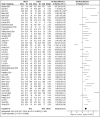Circulating Fibroblast Growth Factor-21 in Patients with Nonalcoholic Fatty Liver Disease: A Systematic Review and Meta-Analysis
- PMID: 40465044
- PMCID: PMC12137391
- DOI: 10.1007/s13679-025-00643-x
Circulating Fibroblast Growth Factor-21 in Patients with Nonalcoholic Fatty Liver Disease: A Systematic Review and Meta-Analysis
Abstract
Background: The pathogenesis of nonalcoholic fatty liver disease (NAFLD) is multifactorial. Fibroblast growth factor-21 (FGF-21) has been proposed to be associated with NAFLD, but data on its circulating levels in patients with NAFLD are to date conflicting.
Aims: The synthesis and comparison of data on circulating FGF-21 between patients with NAFLD and controls without NAFLD.
Methods: A comprehensive literature search was conducted in PubMed, Cochrane Library and Scopus, complemented by hand-searching. Forty-four observational studies with overall 15,563 participants (9548 controls and 6015 NAFLD patients) were included in the study.
Results: Circulating FGF-21 was higher in patients with NAFLD compared to controls (standardized mean difference [SMD]: 0.61; 95% confidence interval [CI]: 0.44, 0.77; p < 0.00001). Subgroup analysis showed higher FGF-21 levels in patients with nonalcoholic steatohepatitis (NASH) compared to controls (SMD: 1.30; 95% CI: 0.35, 2.24; p = 0.007), but not between hepatic steatosis and controls, or hepatic steatosis and NASH. Furthermore, the findings were more robust in the subgroup of studies with NASH-related cirrhosis than those without them (p = 0.0004). Sensitivity analysis further supported the findings. Heterogeneity was high in all comparisons. Meta-regression analyses showed that FGF-21 SMD between NAFLD patients and controls was positively associated with the rate of patients with type 2 diabetes mellitus per study, and this could explain 49.2% of the heterogeneity among studies.
Conclusions: Circulating FGF-21 levels were higher in NAFLD patients than controls, which may be possibly attributed to those with advanced disease (NASH and related cirrhosis). Circulating fibroblast growth factor-21 levels were higher in patients with nonalcoholic fatty liver disease compared to controls. This is primarily attributed to the higher levels observed in patients with advanced disease (steatohepatitis and related cirrhosis).
Keywords: Fibroblast growth factor-21; Metabolic dysfunction-associated steatohepatitis; Metabolic dysfunction-associated steatotic liver disease; Nonalcoholic fatty liver disease; Nonalcoholic steatohepatitis.
© 2025. The Author(s).
Conflict of interest statement
Declarations. Competing interests: The authors declare no competing interests
Figures



References
-
- Polyzos SA, Mantzoros CS. Nonalcoholic fatty future disease. Metabolism. 2015;65:1007–16. 10.1016/j.metabol.2015.12.009. - PubMed
-
- Parola M, Pinzani M. Molecular Aspects of Medicine Liver fibrosis in NAFLD / NASH : from pathophysiology towards diagnostic and therapeutic strategies. Mol Aspects Med. 2024;95: 101231. 10.1016/j.mam.2023.101231. - PubMed
-
- Makri E, Goulas A, Polyzos SA. Epidemiology, Pathogenesis, Diagnosis and Emerging Treatment of Nonalcoholic Fatty Liver Disease. Arch Med Res. 2021;52:25–37. 10.1016/j.arcmed.2020.11.010. - PubMed
Publication types
MeSH terms
Substances
LinkOut - more resources
Full Text Sources
Medical

